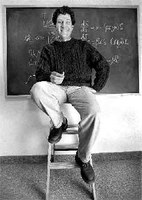Math prof working for wildlife


UPDATED: Thu Nov 23, 2000 10:31 AM
Christine Cox
The Hamilton Spectator
He's an applied mathematics professor at McMaster University, and his work is proof that research in mathematics can be valuable to the public.
"I use mathematics in order to investigate real-world problems," he says.
For example, Earn is using math models to design better vaccination strategies to fight infectious diseases. He's also using math as a tool to help preserve endangered species.
In a paper in the Nov. 17 edition of Science magazine, Earn describes a method to help determine if conservation corridors are a benefit or a threat to endangered species.
"From a mathematical point of view, the way you model these different systems is quite similar. It's just that you're interested in the opposite outcome," Earn pointed out.
In the case of infectious disease, the goal is to control its spread, or ideally, to eradicate it. In conservation, the goal is to prevent extinctions.
Earn, a Winnipeg native, got his undergraduate education and his master's degree in mathematics from the University of Toronto. He has a PhD in theoretical astrophysics from Cambridge.
"I was motivated by wanting to understand the world that we live in, and realized that the sorts of questions I tended to ask could only be answered through mathematics," he said.
The questions that interested him most were about the philosophy of science and mathematics.
Earn, 36, joined the faculty at McMaster in October last year. His wife, Sigal Balshine, is a member of McMaster's psychology department, and studies animal behaviour.
His work on conservation corridors arises from his interest in ecology in general. A researcher from the University of Cambridge and one from Princeton collaborated on this paper.
The natural habitats of many species are being destroyed or fragmented by urban expansion or other developments. Conservation corridors are pathways intended to reduce the impact of fragmentation, by enabling wildlife to move more easily between habitat patches. The idea is that individual members of a particular species will travel from a patch that's doing well to one that's doing badly, and repopulate it.
Earn recently received the Premier's Research Excellence Award. He's looking for a vaccination strategy that would synchronize epidemics, and increase the probability that a disease would burn out between epidemics.
Legal Notice: Contents copyright © 1996-2001, The Hamilton Spectator. All rights reserved. Distribution, transmission or republication of any material from www.hamiltonspectator.com is strictly prohibited without the prior written permission of The Hamilton Spectator. For information contact us or send email to jaussem@hamiltonspectator.com

